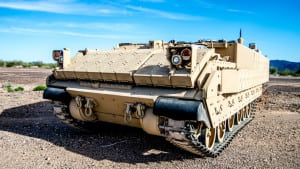BAE Systems’ delivery of the first Armored Multi-Purpose Vehicles (AMPV) to the Army was delayed a month due pandemic-related challenges, with initial vehicles now set to arrive this August.
The delivery pushback follows an original delay of several months due to manufacturing issues BAE Systems addressed with its AMPV production line.

“We have worked tirelessly to mitigate the impacts from COVID-19 with our employees, supply network, and customer base to keep our manufacturing sites operational and continue to receive parts as needed. Unfortunately, we could not overcome all the challenges and our first delivery has slipped one month, ” Amanda Niswonger, a company spokesperson told Defense Daily.
AMPV is the Army’s program to replace its legacy M113 armored personnel carriers, with BAE Systems receiving $575 million in contract modifications last February to move into low-rate initial production (Defense Daily, Feb. 19).
BAE Systems previously told Defense Daily the first of those LRIP vehicles were set to be delivered this spring.
The delay of deliveries by several months from spring to July was due to the company’s installing of modernized manufacturing equipment, including robotic welding, digital X-ray, and advanced machining, to incorporate efficiencies in the AMPV production process, according to Niswonger.
“We worked closely with the Army to update and refine manufacturing processes to incorporate the most modern weld and inspection technology. These changes had an impact on our delivery timeline which was not reflected in the original delivery schedule, but continues to meet the Army’s fielding schedule,” Niswonger said.
The Army has previously detailed plans to stretch its AMPV buy to shift funds toward modernization efforts, with the service budgeting for $193 million for procurement in FY ‘21, down from $445 million in FY ‘20 (Defense Daily, Feb. 11).
A report last week from GlobalData analysts following BAE Systems’ latest second quarters earnings update said the AMPV is not expected to face any additional obstacles” in the second half of the year with the Army considering the program “within cost, schedule and performance baselines.”